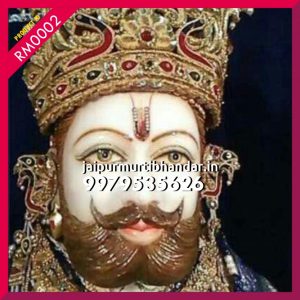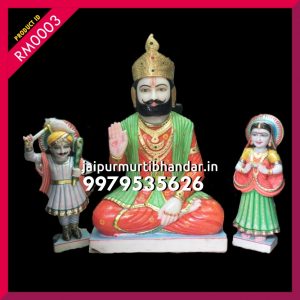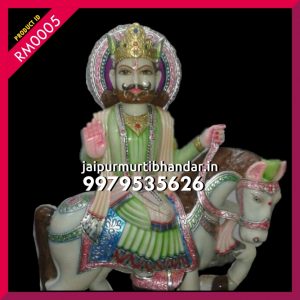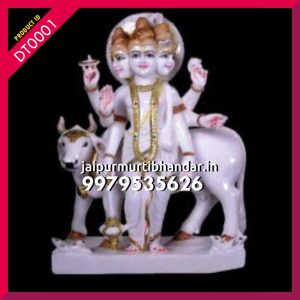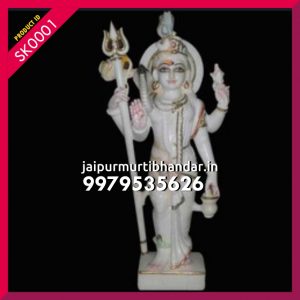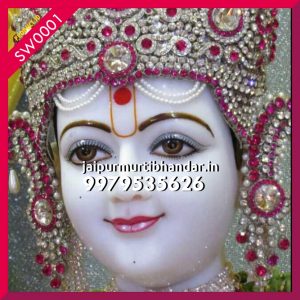-
Krishna -KR0027
Krishna is represented in the Indian traditions in many ways, but with some common features. His iconography typically depicts him with black, dark, or blue skin, like Vishnu.However, ancient and medieval reliefs and stone-based arts depict him in the natural color of the material out of which he is formed, both in India and in southeast Asia.In some texts, his skin is poetically described as the color of Jambul (Jamun, a purple-colored fruit).
Krishna is often depicted wearing a peacock-feather wreath or crown, and playing the bansuri (Indian flute). In this form, he is usually shown standing with one leg bent in front of the other in the Tribhanga posture. He is sometimes accompanied by cows or a calf, which symbolise the divine herdsman Govinda. Alternatively, he is shown as a romantic and seductive man with the gopis (milkmaids), often making music or playing pranks.
Krishna lifting Govardhana at Bharat Kala Bhavan, recovered from a Muslim graveyard in Varanasi. It is dated to the Gupta Empire era.
In other icons, he is a part of battlefield scenes of the epic Mahabharata. He is shown as a charioteer, notably when he is addressing the Pandava prince Arjuna character, symbolically reflecting the events that led to the Bhagavad Gita ? a scripture of Hinduism. In these popular depictions, Krishna appears in the front as the charioteer, either as a counsel listening to Arjuna, or as the driver of the chariot while Arjuna aims his arrows in the battlefield of Kurukshetra. -
Krishna -KR0028
Krishna is represented in the Indian traditions in many ways, but with some common features. His iconography typically depicts him with black, dark, or blue skin, like Vishnu.However, ancient and medieval reliefs and stone-based arts depict him in the natural color of the material out of which he is formed, both in India and in southeast Asia.In some texts, his skin is poetically described as the color of Jambul (Jamun, a purple-colored fruit).
Krishna is often depicted wearing a peacock-feather wreath or crown, and playing the bansuri (Indian flute). In this form, he is usually shown standing with one leg bent in front of the other in the Tribhanga posture. He is sometimes accompanied by cows or a calf, which symbolise the divine herdsman Govinda. Alternatively, he is shown as a romantic and seductive man with the gopis (milkmaids), often making music or playing pranks.
Krishna lifting Govardhana at Bharat Kala Bhavan, recovered from a Muslim graveyard in Varanasi. It is dated to the Gupta Empire era.
In other icons, he is a part of battlefield scenes of the epic Mahabharata. He is shown as a charioteer, notably when he is addressing the Pandava prince Arjuna character, symbolically reflecting the events that led to the Bhagavad Gita ? a scripture of Hinduism. In these popular depictions, Krishna appears in the front as the charioteer, either as a counsel listening to Arjuna, or as the driver of the chariot while Arjuna aims his arrows in the battlefield of Kurukshetra. -
Ramdev Ji: RM0001
Ramdev is considered to be an incarnation of Vishnu. King Ajmal(Ajaishinh) married Queen Minaldevi, daughter of Pamji Bhati of Chhahan Baru village. The childless king went to Dwaraka and pleaded with Krishna about his wish to have child like him. They had two sons, Viramdev and the younger Ramdev. Ramdev was born on Bhadarva Shukla Dooj in V.S. 1409 at Ramderiya, Undu and Kashmir in Barmer district. Ramdevji was a Tanwar.
Muslims venerate Ramdev as Ramshah Pir or Rama Shah Peer. He was said to have had miraculous powers and his fame reached far and wide. Legend has it that five Pirs from Mecca came to test Ramdev’s powers. Ramdev after initial welcoming requested them to have lunch with him. But Pirs said they eat in their personal utensils, which are lying in Mecca, so they cannot have their meals. On this, Ramdev smiled and said look your utensils are coming and they saw that their eating bowls were coming flying in air from Mecca. After being convinced of his abilities and powers, they paid their homage to him and named him Rama Shah Peer. The five Pirs, who came to test his powers, were so overwhelmed by his powers that they decided to stay with him and Samadhi of these five are also near Samadhi of Ramdev.
-
Ramdev Ji: RM0002
Ramdev is considered to be an incarnation of Vishnu. King Ajmal(Ajaishinh) married Queen Minaldevi, daughter of Pamji Bhati of Chhahan Baru village. The childless king went to Dwaraka and pleaded with Krishna about his wish to have child like him. They had two sons, Viramdev and the younger Ramdev. Ramdev was born on Bhadarva Shukla Dooj in V.S. 1409 at Ramderiya, Undu and Kashmir in Barmer district. Ramdevji was a Tanwar.
Muslims venerate Ramdev as Ramshah Pir or Rama Shah Peer. He was said to have had miraculous powers and his fame reached far and wide. Legend has it that five Pirs from Mecca came to test Ramdev’s powers. Ramdev after initial welcoming requested them to have lunch with him. But Pirs said they eat in their personal utensils, which are lying in Mecca, so they cannot have their meals. On this, Ramdev smiled and said look your utensils are coming and they saw that their eating bowls were coming flying in air from Mecca. After being convinced of his abilities and powers, they paid their homage to him and named him Rama Shah Peer. The five Pirs, who came to test his powers, were so overwhelmed by his powers that they decided to stay with him and Samadhi of these five are also near Samadhi of Ramdev.
-
Ramdev Ji: RM0003
Ramdev is considered to be an incarnation of Vishnu. King Ajmal(Ajaishinh) married Queen Minaldevi, daughter of Pamji Bhati of Chhahan Baru village. The childless king went to Dwaraka and pleaded with Krishna about his wish to have child like him. They had two sons, Viramdev and the younger Ramdev. Ramdev was born on Bhadarva Shukla Dooj in V.S. 1409 at Ramderiya, Undu and Kashmir in Barmer district. Ramdevji was a Tanwar.
Muslims venerate Ramdev as Ramshah Pir or Rama Shah Peer. He was said to have had miraculous powers and his fame reached far and wide. Legend has it that five Pirs from Mecca came to test Ramdev’s powers. Ramdev after initial welcoming requested them to have lunch with him. But Pirs said they eat in their personal utensils, which are lying in Mecca, so they cannot have their meals. On this, Ramdev smiled and said look your utensils are coming and they saw that their eating bowls were coming flying in air from Mecca. After being convinced of his abilities and powers, they paid their homage to him and named him Rama Shah Peer. The five Pirs, who came to test his powers, were so overwhelmed by his powers that they decided to stay with him and Samadhi of these five are also near Samadhi of Ramdev.
-
Ramdev Ji: RM0004
Ramdev is considered to be an incarnation of Vishnu. King Ajmal(Ajaishinh) married Queen Minaldevi, daughter of Pamji Bhati of Chhahan Baru village. The childless king went to Dwaraka and pleaded with Krishna about his wish to have child like him. They had two sons, Viramdev and the younger Ramdev. Ramdev was born on Bhadarva Shukla Dooj in V.S. 1409 at Ramderiya, Undu and Kashmir in Barmer district. Ramdevji was a Tanwar.
Muslims venerate Ramdev as Ramshah Pir or Rama Shah Peer. He was said to have had miraculous powers and his fame reached far and wide. Legend has it that five Pirs from Mecca came to test Ramdev’s powers. Ramdev after initial welcoming requested them to have lunch with him. But Pirs said they eat in their personal utensils, which are lying in Mecca, so they cannot have their meals. On this, Ramdev smiled and said look your utensils are coming and they saw that their eating bowls were coming flying in air from Mecca. After being convinced of his abilities and powers, they paid their homage to him and named him Rama Shah Peer. The five Pirs, who came to test his powers, were so overwhelmed by his powers that they decided to stay with him and Samadhi of these five are also near Samadhi of Ramdev.
-
Ramdev Ji: RM0005
Ramdev is considered to be an incarnation of Vishnu. King Ajmal(Ajaishinh) married Queen Minaldevi, daughter of Pamji Bhati of Chhahan Baru village. The childless king went to Dwaraka and pleaded with Krishna about his wish to have child like him. They had two sons, Viramdev and the younger Ramdev. Ramdev was born on Bhadarva Shukla Dooj in V.S. 1409 at Ramderiya, Undu and Kashmir in Barmer district. Ramdevji was a Tanwar.
Muslims venerate Ramdev as Ramshah Pir or Rama Shah Peer. He was said to have had miraculous powers and his fame reached far and wide. Legend has it that five Pirs from Mecca came to test Ramdev’s powers. Ramdev after initial welcoming requested them to have lunch with him. But Pirs said they eat in their personal utensils, which are lying in Mecca, so they cannot have their meals. On this, Ramdev smiled and said look your utensils are coming and they saw that their eating bowls were coming flying in air from Mecca. After being convinced of his abilities and powers, they paid their homage to him and named him Rama Shah Peer. The five Pirs, who came to test his powers, were so overwhelmed by his powers that they decided to stay with him and Samadhi of these five are also near Samadhi of Ramdev.
-
Dutt -DT0001
Shri Guru Dattatreya or Shri Datta Guru is Hindu deity (Ishta Devata) encompassing the trinity of Brahma, Vishnu and Shiva, collectively known as Trimurti. The name Dattatreya can be divided into two words – “Datta” (meaning given) and “Atreya” means, in Sanskrit, “son of Athri”. Athri is one of the 7 seers / principles of creation. Athri also means in Sanskrit “not three”. The one who came down from that which is not three is called Athreya. Dattatreya is also a combination of ?Datta? and ?treya? – Treya being the trinity ? Bramha (creator), Vishnu (preserver) and Shiva (destroyer).
In the Nath tradition Dattatreya is recognized as an Avatar or incarnation of the Lord Vishnu and as the Adi-Guru (first teacher) of the Adinath Sampradaya of the Naths. Dattatreya is primal manifestation in the Guru tradition (Supreme Guru principal). Dattatreya is considered to be the presiding deity (Ishta Devata) for the path of yoga ? therefore called as “Lord of Yoga”.
Shri Dattatreya is also known by another equally popular name of ?Avadhut?. Avadhut is one who washes away the temperamental defects i.e. the three qualities or Trigunas ? Sattva (Purity and Knowledge) Raja (Activity and Passion), Tama (Ignorance and Inertia). He destroys Trigunas. He bestows the spiritual experience of the unmanifest principle. Importance of Lord Datta from the seekers point of view is – There are many deities (Ishta Devatas or Ishvara) in Hindu religion, but there is only who is worshipped in the form of a Guru ? and he is Lord Datta. Hence the extolling (Jai-ghosh) of ?Avadhut Chintana Jai Gurudev Datta?. Shri Datta Guru is the ideal of the Guru principle and a proponent of Yoga.
-
Sai Baba : SB-0001
Sai Baba was a born to a Brahmin couple of Patri which was in the Nizam state of British India. Where his parents handed over him to the fakir. These were the words revealed by baba in his last days. But Date of birth is still unknown to the world. There are lots of communities who claims that Baba belong to their respective communities but none of them proven.
-
Shankar : SK-0001
In the Hindu mythology, Lord Shiva is the Destroyer and the most important one in the Holy Trinity, the other two being Brahma the Creator and Vishnu the Protector. Lord Shiva has always fascinated his followers by his unique appearance: he has not two but three eyes, has ash smeared all over his body, has snakes coiled up around his head and arms, wears tiger and elephant skin, leads a wild life in the cremation grounds far removed from social pretenses, and is known for his proverbial anger..
-
Shrinath Ji : SH-0001
Shrinathji?s idol was brought to Rajasthan from Govardhana near Vrindavan to protect it from the hands of the Mughal emperor Aurangzeb who in 1665 was bent upon vandalizing the area of Vrindavan by widespread destruction of Hindu temples. When the Mughal army came to Govardhana, the devotees of the Lord showed them the titles and gifts given to the temple by the previous Mughal rulers. The army commander then ordered the deity to be taken away from Govardhana. For almost six months the statue stayed in Agra after which the custodians of the idol of Shrinathji left that place with the idol in search of a new heaven.
-
Swaminarayan : SW-0001
The Swaminarayan Sampraday began as the Uddhav Sampraday and was led by Ramanand Swami. In 1799, Swaminarayan, born as Ghanshyam Pande, was initiated into the Uddhav Sampraday as an ascetic (Sadhu) by his guru, Ramanand Swami, and given the name “Sahajanand Swami”. At the age of 21, Neelkanth Varni was given the leadership of the sect known as Uddhav Sampraday with the blessings of Ramanand Swami, who handed him control of the religious diocese shortly before his death. Fourteen days after Ramanand Swami died, Neelkanth Varni, now known as Sahajanand Swami, held a large gathering of followers at the town of Faneni. It was during this meeting that Swaminarayan introduced what he termed “the father of all Mantras” and described it as “maha” (or great).[8] Then he was known as Swaminarayan, and the name “Swaminarayan Sampraday” came into existence.
At the age of 49, Swaminarayan took Samadhi at Gadhada in 1830 and died, after he promised to remain within the Swaminarayan Sampraday in the images he installed (and by the Acharyas succeeding him), the Acharyas and saints installed by him (and those in direct succession), the saints he initiated (and those initiated by succeeding Acharyas) and the scriptures, such as Shikshapatri, Vachanamrut, Satsangi Jeevan, Nishkhulanand Kavya and Yamdand (and those authorised by succeeding Acharyas).
God Idols
- Home
- Shop
- Marble Statue
- God Idols

 +91 9979 535 626
+91 9979 535 626


